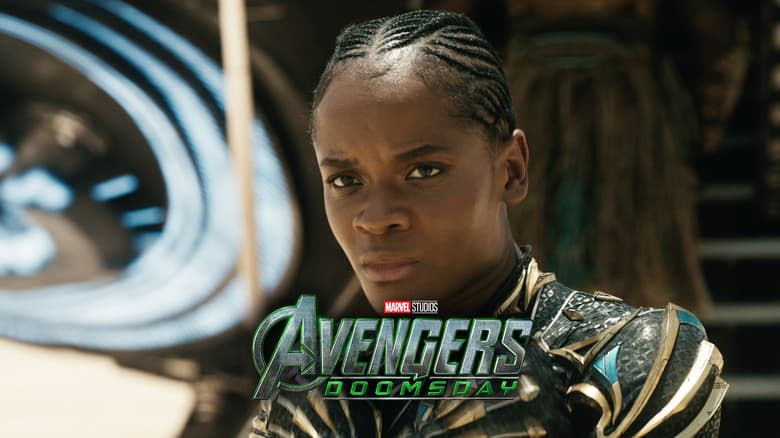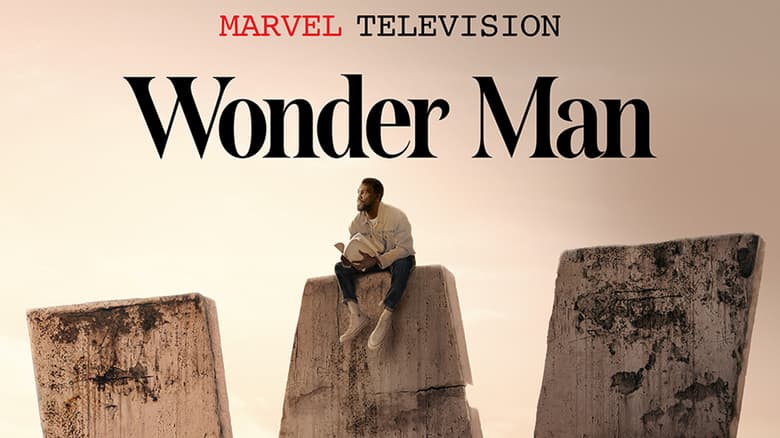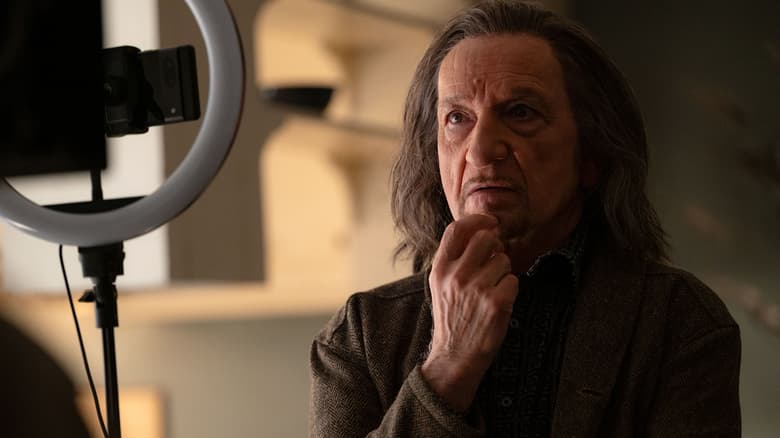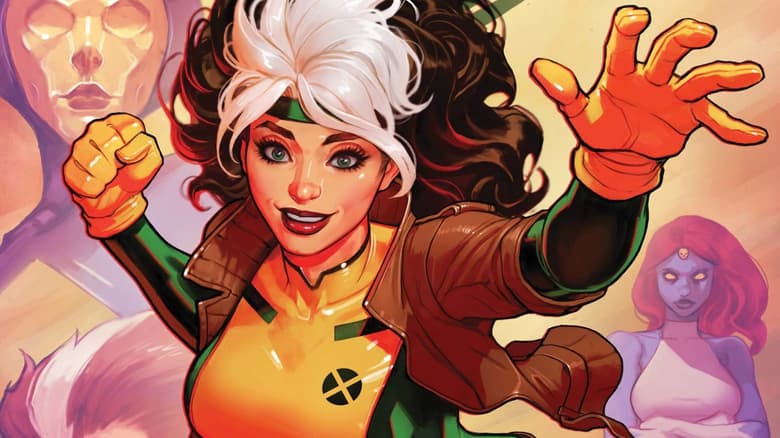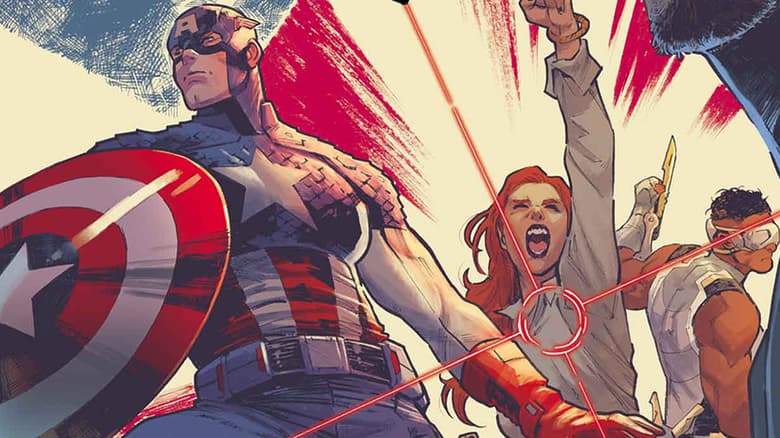Signaling a Sentinel of Liberty
Collin Kelly, Jackson Lanzing, and Carmen Carnero carry the torch for the next phase of Steve Rogers’ tour as Cap in upcoming series ‘Captain America: Sentinel of Liberty.’
As seen recently in CAPTAIN AMERICA (2018) #0, two men currently carry the legendary shield: original Super-Soldier Steve Rogers as well as his longtime partner and the former Falcon Sam Wilson. The classic Cap’s story spills over into the ongoing CAPTAIN AMERICA: SENTINEL OF LIBERTY (2022) series, written by the daring duo of Collin Kelly and Jackson Lanzing with beautiful art by Marvel Stormbreaker Carmen Carnero. We assembled the trio to ask about their own formative days in comics, plus plans for Steve, Bucky Barnes, and company!

OK, first and foremost, can all three of you let me know how you became comic book fans in the first place? Beyond that, what are your formative memories of Marvel as well as Captain America specifically?
JACKSON LANZING: I had a great example in my parents. My dad had a deep personal library of science fiction novels, while my mom was a huge Neil Gaiman fan. I started reading The Books of Magic and Sandman far too early—but they strangely became my introduction into the world of DC Comics. I started buying Marvel books on my own not long after, using what meager savings I could manage. I was a voracious Spider-Man reader during the “Clone Saga.” I remember Ben Reilly’s ascension to Peter Parker’s place in the Marvel canon very vividly. But I didn’t find Captain America until high school, in that post-9/11 uncertainty for the character, through ULTIMATES (2002) and then more affectionately through Ed Brubaker’s 2004 run. Steve Rogers became a north star for me when it came to human decency, and I’ll admit, he was the first character I fantasized about writing someday.
COLLIN KELLY: For me, the story is easy: I was a voracious reader, and liked to sample from all corners of the library. One day that brought me to the graphic novel section, full of characters that I had heard about culturally, but had never really gotten to engage with. And they were a treasure trove of stories—amazing stories—that I was able to dive into, all with the power of one little plastic card. So, in closing, support your local libraries!
CARMEN CARNERO: I started very late reading comics and only read the authors that interested me artistically, which I know is something unusual. I remember my first Marvel comic was MARVELS (1994) by Kurt Busiek and Alex Ross. I couldn't believe someone did those interiors! Regarding Captain America, it was later when I was an aspiring comic book artist and I remember without a doubt that the first one I read was a Carlos Pacheco issue. At that time I was obsessed with his drawings and narrative skills—and still am!
Now, how did each of you come to comics as pros—your origin stories if you will?
COLLIN KELLY: After a long break from comics, I was actually pulled back into it by college friends, including Mr. Jackson Lanzing. We would pile into our friend David Server’s silver PT Cruiser, and every week would drive across Los Angeles to pick up our books, eat pizza, and argue about continuity, like all good fans should. Those early gatherings forged the bond that would later become Jack and my writing career—it turns out that arguing with someone for four years straight forms an amazing foundation for creative collaboration.
JACKSON LANZING: David is instrumental not just in connecting Collin and I, but in starting our career in comics. Dave and I had written a comic in college together, FREAKSHOW, which we published in 2011 with art by Joe Suitor and letters by Deron Bennett. It was a remarkable experience, creatively fulfilling and deeply exciting.
CARMEN CARNERO: In my case, I was about 16 or 17-years-old when I had a comic book in my hands for the first time. I went to a friend's house, who had a huge library and that was really the moment when the spark was lit. Later I studied fine arts while working on small illustration jobs and when I was working on my thesis I took a course on comics where they taught you how to create a portfolio among other things. Among the teachers of that course was Joe Kubert himself as well as editors from Marvel and DC. There they saw some sequential pages I did that I'm really ashamed of [Laughs], but it seems that they saw some potential there. And so, after a lot of page tests and hard work, I got my first job at Marvel.
What made this gig, writing and drawing Steve Rogers as Captain America, appealing?
COLLIN KELLY: Captain America is… everything. When there wasn’t a single comic shop in my town, I got issues of Mark Gruenwald’s run mailed to me—folded up and stuffed into a mailbox, of course. [Cap] was—and is—the symbol of our times, the best of what our country can be. We grew up in a nation that has been at war for almost our entire adult lives, and yet Steve Rogers has never flinched from standing up for what he—what all of us—should believe in: freedom, justice, and liberty for everyone, not just those who pull the strings of power.
JACKSON LANZING: We’ve also had an idea for the wider Captain America mythos for several years, one we’d always figured was too big and wild for Marvel to ever let us write. But when [editors] Alanna Smith and Tom Brevoort came calling, the idea seemed to only breed more excitement and opportunity. So here we are, pulling the trigger on an impossible dream.
CARMEN CARNERO: Drawing Captain America is a huge responsibility and who says no to an opportunity like this! My biggest fear was what could we tell about the character that hadn't already been done, but when Alanna told me Jackson and Collin were on the book, I asked for the pitch because we had worked together before, and as expected that pitch was absolutely incredible. It was impossible to turn down this opportunity with a story so rich in detail and passion for the character.
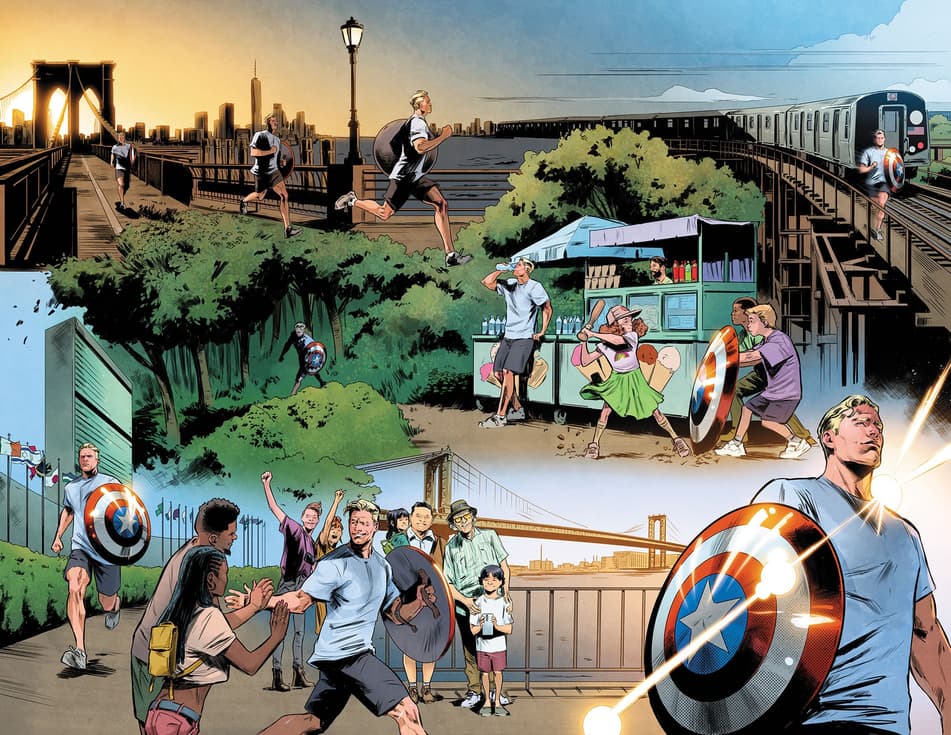
Why do you think after all these years, Steve Rogers still endures and inspires stories?
JACKSON LANZING: I think he’s objectively the best humanity has to offer. He’s a guy who knows what it’s like to be undervalued, left behind, and stepped on—the target of bullying and disregard—who was gifted incredible power. And instead of channeling his experience into anger or revenge or cynicism, he used it to become more empathetic. He’s a man who has seen war and learned that the glory there is fleeting. He’s a man who has seen America at its worst—and seeks to find a way to inspire the best. As a kid who grew up with Spina bifida in the 9/11 era, Steve Rogers has been the angel on my shoulder countless times in my life, compelling me to push for the good. To give back to that mythos—that psychic continuum of decency—is an honor and a privilege.
CARMEN CARNERO: Steve has been present in several generations. He’s a symbol, part of popular culture, but above all he’s always the force for good and that can never be lost.
What are your goals for CAPTAIN AMERICA: SENTINEL OF LIBERTY?
COLLIN KELLY: We want to build on the legacy of what has been, while launching forward into what will be. We’re introducing new ideas, and new threats—while also respecting everything that has come before. And exploring Steve himself—who he is when he’s not wearing the uniform, or carrying the shield—is paramount to that journey. In our very first issue, we’re returning him to the Lower East Side Manhattan apartment he grew up in and surrounding him with real, everyday civilian friends. Captain America’s problems are American problems, and we never want to lose sight of the fact that he may represent an ideal…but it’s the people he fights for.
JACKSON LANZING: We’re also looking to expand the role of Bucky Barnes. Bucky is a character who’s had a hard time of things since his return to heroism—not least because he never went through a truly redemptive experience. He was cured by fiat—forgiveness by the Cosmic Cube—and he’s been in the same loop of violence and regret ever since. We’re eager to give him a journey that embraces that cycle and asks if there’s a way for him to break out. And what exactly that might cost.
CARMEN CARNERO: My goal is to do justice to the Hivemind’s work, to be able to draw all their ideas in a reliable way. Of course we also want to create something different, something that lasts over time, to motivate readers with an exciting new story. To try to achieve that we also wanted to expand Steve's human side showing his day to day life when he is not wearing the uniform while he's dealing with the long scale events he's researching.
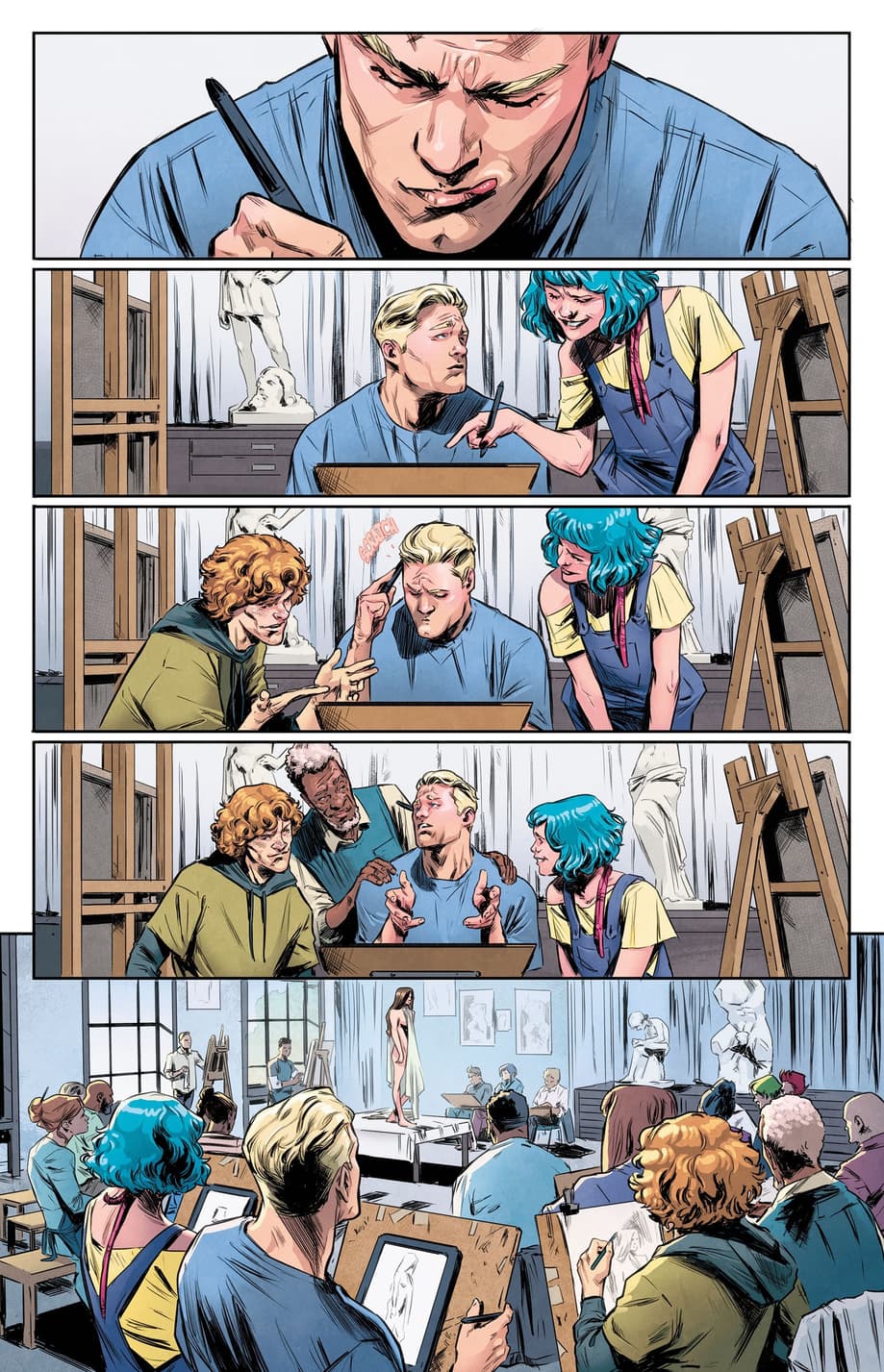
With two ongoing Captain America books—this one and CAPTAIN AMERICA: SYMBOL OF TRUTH—and two ongoing Caps—Steve as well as Sam Wilson—how does that alter the landscape?
JACKSON LANZING: I think it’s really freeing for both teams. [“Symbol of Truth” writer] Tochi Onyebuchi and [artist] R.B. Silva are under no obligation to explain or wave away Steve Rogers, while we’re freed of any obligation to “play the hits” when it comes to Captain America’s rogues’ gallery. Sam Wilson’s Captain America can team with Deadpool, fight Crossbones, face down Doctor Doom—and each encounter feels fresh and new. He has his own supporting cast, his own objectives, his own tone, his own focus. Meanwhile, Steve gets to dig into new story territory after 80 plus years—as we try and push his story into the next era. Ideally, it works a bit like the X-Men in the Krakoa Era, creating room for a whole corner of the Marvel Universe painted with the stars and stripes.
What kind of threats will Steve continue to focus on?
COLLIN KELLY: Without spoiling some of the twists in the first issue, what we can say is this: there is a secret at the heart of Captain America’s legacy that is only now being uncovered. Bucky got a taste of it in our DEVIL’S REIGN: WINTER SOLDIER #1 tie-in issue, but now the threat is coming to roost. That secret—that threat—is larger than anything he could have dreamed up, a web of intent that touches every aspect of the last century.
JACKSON LANZING: What kinds of threats? New ones. And also very old ones. Ones who will force him to reexamine his relationship not just with the shield…but with the entire 20th century.
As you said, Bucky is clearly going to be a focal point of this book, perhaps even a bonafide co-star—what does he bring to the table and what can we expect from him?
COLLIN KELLY: Jack and I…you might hear us called “The Hivemind,” because we’ve been working together for so long we basically share a creative soul. We have something to say about the kind of friendship you build when it’s just the two of you against the world…and to us that is Bucky and Cap. You can’t have one without the other—you can know each man’s quality by the love of his best friend. That being said…Bucky has secrets, and trauma, that Steve will never really understand. These two are best friends. But even best friends have disagreements. And sometimes, it’s your best friend who can hurt you the most.
This new Destroyer is a very interesting initial bad guy to showcase. Where did he come from?
JACKSON LANZING: CAPTAIN AMERICA: SENTINEL OF LIBERTY is deeply concerned with issues of legacy and the fight against fascism—especially in how that fight has changed over one hundred years. The Destroyer is a character I’ve loved for a long time, a kind of funhouse mirror version of Captain America who wears his darkness on his sleeve but fights the good fight all the same. He’s just cool as hell. But this new Destroyer represents something deeper in our story—showing us that the fight against fascism may be a much more nuanced game than just “punching Nazis.” Where he comes from, where he leads, what he represents, and the secrets he holds are all the first clue down the larger mystery that is SENTINEL OF LIBERTY.
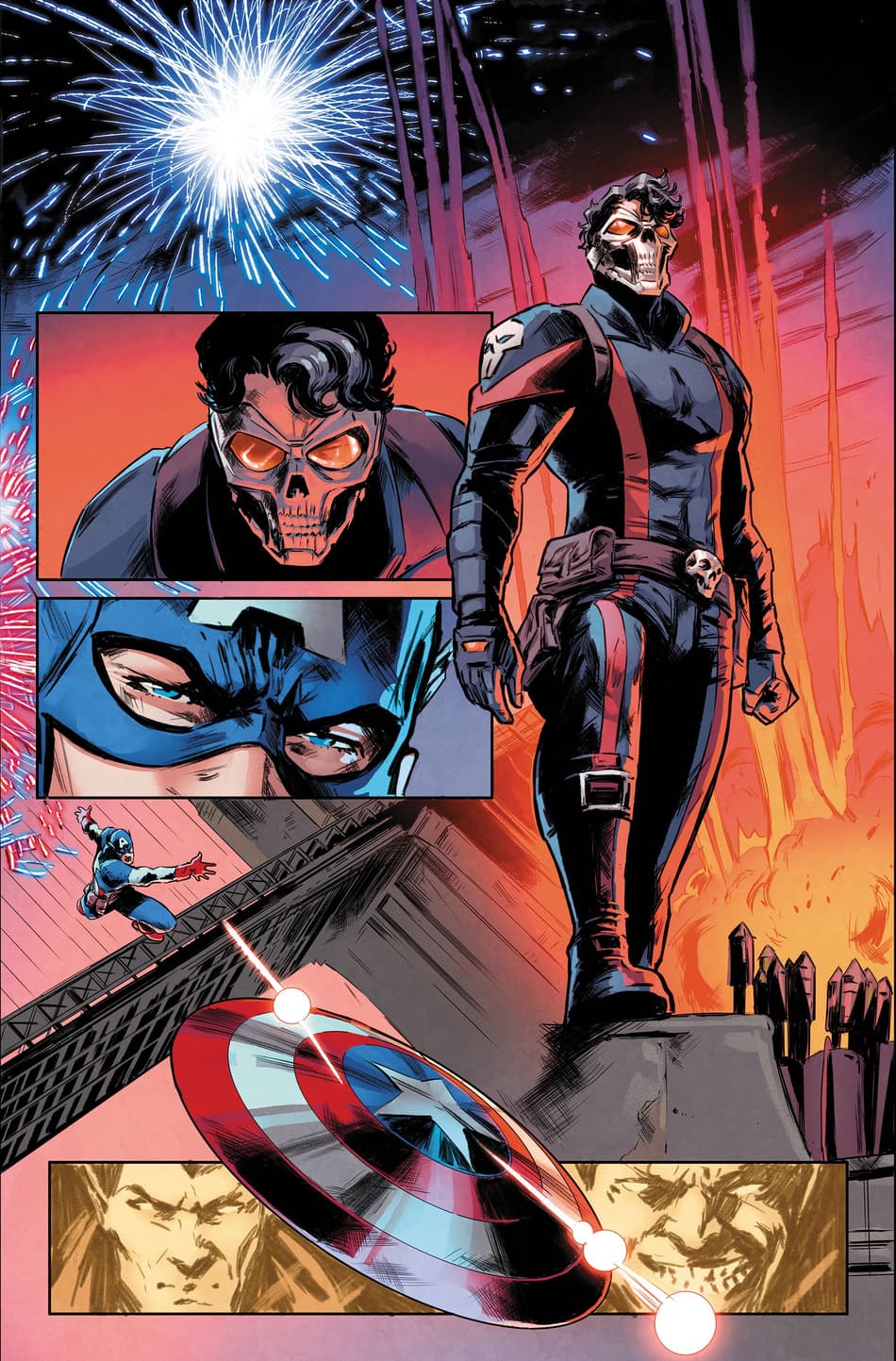
Collin and Jackson, how do you work together as a writing team and how does your process alter from when either of you are going it alone?
COLLIN KELLY: You don’t see a lot of writing teams in comics—especially exclusive writing teams like the two of us. We’ve been working together for…almost 15 years now, working in pretty much every medium you can throw at us. Our process has been honed to a razor’s edge, but it really comes down to two things: respect and well-planned outlines. Respect comes first—respect for the other’s ideas, for their passion, and for the fact that their idea might be better than yours. That respect lets us argue like absolute demons…but we know it’s not personal. It’s about telling the best story, and that requires passion! Then, once the arguing is done, we lock that outline into place, cut it down the middle, go off to our corners, write up a storm, come back, do passes over each other’s work, slap it together, and “BOOM”! As for going it alone…that’s a pass from me. Writing alone is too hard—I’d much rather do it with my best friend.
JACKSON LANZING: Extreme same.
Carmen, what’s it like taking on a costume as iconic as Steve’s Captain America suit? Do you look to homage some of the greats, or go your own direction?
CARMEN CARNERO: In this case it was an homage since the team decided to keep using the classic costume and the only thing I did was to add small details that can remind us of other runs, and at the same time make this one recognizable by its own look. I always think about the practicality of the costume and to give examples of those small details: adding a small collar to cover the neck and jugular area, a chainmail that looks more robust and sharp rather than a simple ornament, tactical gloves and boots... As I said very little details but very respectful with the classic look.

Finally, what are some Captain America runs and creators of yore, recent or in the more distant past, whom you all take inspiration from?
COLLIN KELLY: Recently, I think we have to take our hats off to Christopher Cantwell’s THE UNITED STATES OF CAPTAIN AMERICA (2021). Not only is the Captain Network an amazing idea, incredibly well executed, but it helped open Steve’s eyes to the reality that is our country, wounds and all. If fans are looking for the most direct influence on our story though? They should look no further than Brubaker’s Winter Soldier arc. Remember when we mentioned Bucky’s trauma? Even with a Cosmic Cube, some wounds never heal…
JACKSON LANZING: So, obviously, as we deal with Bucky Barnes, we will always be in debt to the Brubaker era—those books were my roots with Captain America. But casting a bit further back, the Mark Waid/Ron Garney/Andy Kubert era didn’t just inspire our book’s name—its thoughtful understanding of Steve’s journey into the modern era was a huge tonal inspiration for us. Similarly, the Mark Gruenwald run is legendary for a reason—and its exploration of both the deeply troubled nature of Steve’s mantle and Steve’s civilian life are elements we’re eager to bring back in our own, 21st century way.
CARMEN CARNERO: Apart from what they mentioned, when I started I really liked Rick Remender's era with Carlos Pacheco drawing Steve, and Stuart Immonen drawing Sam Wilson. Also Daniel Acuña and Nick Spencer’s CAPTAIN AMERICA: SAM WILSON (2015)! For me those series are at a stratospheric level artistically speaking.
Follow the latest trials of Steve Rogers issue-by-issue in CAPTAIN AMERICA: SENTINEL OF LIBERTY (2022) when issue #1 hits stands June 15! Find and support your local comic book shop by visiting Marvel.com/LoveComicShops.
For digital comics, all purchases in the Marvel Comics app can be read on iPhone®, iPad® and select Android™ devices! Our smart-paneling feature provides an intuitive reader experience, ideal for all types of mobile device and tablet users! Download the app on iOS and Android.
The Daily Bugle
Can’t-miss news and updates from across the Marvel Universe!
